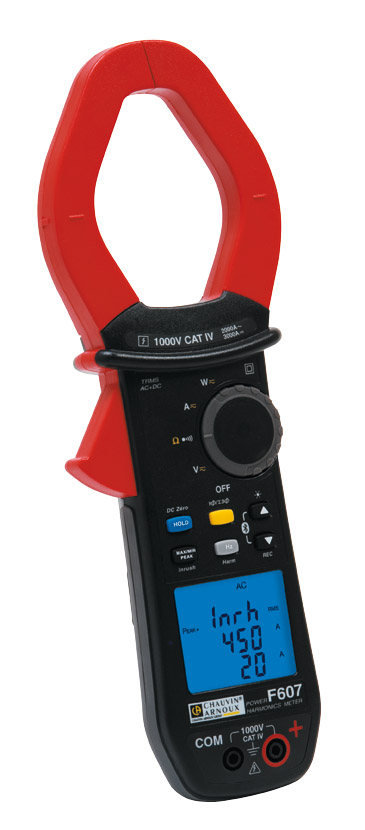
Clamp meters and power quality analysers (PQA) can be used to measure and monitor inrush current in order to prevent inconvenient and irritating flickering lights, crashing computers, and tripping circuit breakers. However, Chauvin Arnoux has identified a failing of traditional clamp meters and PQAs: most can only measure inrush current in a system that is initially switched off. This makes them ill-equipped for measuring inrush current that is drawn when a load (light, computer, or motor) is connected to a live installation. Chauvin Arnoux’s True InRush® function, available on a range of their clamp meters and power quality analysers, provides a solution to this issue as Julian Grant explained in a recent EM Magazine article, Uncovering the truth about inrush current.[1]
Quick Links
- What is Inrush Current?
- Why is Inrush Current a Problem?
- What is Chauvin Arnoux’s True InRush® Function?
- How Does Chauvin Arnoux’s True InRush® Function Work?
- Chauvin Arnoux Clamp Meters & PQAs
- Further Information
What is Inrush current?
Inrush current is the current drawn by a load, e.g., motors, lights, or IT equipment, on initial start-up. It is often significantly larger than the steady-state current which appliances settle into a few seconds after being powered on.[2]
Why is Inrush Current a problem?
Large inrush currents can trip circuit protection equipment and cause voltage drops across other loads connected to the installation, resulting in all sorts of issues ranging from flickering lights to malfunctioning IT equipment to blown fuses.[3]
What is Chauvin Arnoux’s True InRush® Function?
Chauvin Arnoux has specifically designed their True InRush® function to measure the inrush current drawn by a load regardless of whether the system was initially powered on. This allows the user to measure both the initial inrush current caused by the first load to be connected to the installation, as well as the inrush currents drawn by all subsequent loads connected to the circuit.[4]
How Does Chauvin Arnoux’s True InRush® Function Work?
Chauvin Arnoux’s True InRush® function is simple and easy-to-use. It utilises a novel measurement algorithm that works in the following way:
- Captures the installation’s steady-state current
- Filters the steady-state current to remove anticipated normal variations to determine an RMS reference current
- Conducts half-period monitoring
- Calculates the equivalent RMS current for every half cycle of the supply
- If the calculated half-cycle RMS current exceeds user-defined thresholds this indicates an inrush event has occurred
- If an inrush event is detected, the clamp meter or PQA will conduct measurements every millisecond for 100ms
- After 100ms, the results are processed digitally to calculate the true inrush current for this time[5]
Chauvin Arnoux’s True InRush® function allows you to pinpoint issues in your installation such as problem loads. This makes it easier to take suitable corrective action, for example, installing a soft starter or a variable speed drive and/or upgrading circuit breakers and fuses. Once improvements have been implemented, Chauvin Arnoux’s True InRush function should be used again to assess the efficacy of these changes.[6]
Chauvin Arnoux Clamp Meters & PQAs
Chauvin Arnoux has integrated its innovative True InRush® function into a range of clamp meters and power quality analysers. Please click the following links to read more about these products.
Clamp Meters
- Chauvin Arnoux F201 AC Clamp Meter
- Chauvin Arnoux F205 Clamp Meter
- Chauvin Arnoux F401 Clamp Meter
- Chauvin Arnoux F403 Clamp Meter
- Chauvin Arnoux F407 Harmonic Clamp Meter
- Chauvin Arnoux F603 Clamp Meter
- Chauvin Arnoux F605 Clamp Meter
- Chauvin Arnoux F607 Harmonic Clamp Meter
To view our complete collection of Chauvin Arnoux AC/DC clamp meters, please follow this link.
Power Quality Analysers
- Chauvin Arnoux CA8336 Qualistar+ Power Analyser
- Chauvin Arnoux CA8336 Power Quality Analyser (Choice of Kit)
- Chauvin Arnoux CA8436 Qualistar+ Power Quality Analyser
Please follow this link to view our full selection of Chauvin Arnoux power quality analysers.
Further Information
For further information regarding any of Chauvin Arnoux’s clamp meters or power quality analysers, please do not hesitate to contact our Sales team on 01642 931 329 or via our online form.
Please click the following links to browse our comprehensive range of clamp meters, power quality analysers, and Chauvin Arnoux products.
[1] EM Magazine, Uncovering the truth about inrush currents, last accessed 08 February 2021 < https://www.energymanagermagazine.co.uk/uncovering-the-truth-about-inrush-currents/>
[2] EM Magazine, Uncovering the truth about inrush currents
[3] EM Magazine, Uncovering the truth about inrush currents
[4] EM Magazine, Uncovering the truth about inrush currents
[5] EM Magazine, Uncovering the truth about inrush currents
[6] EM Magazine, Uncovering the truth about inrush currents




